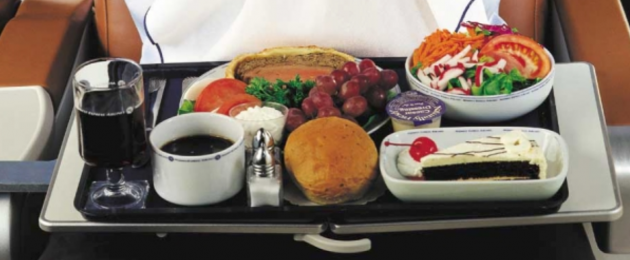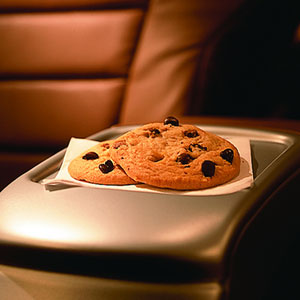Shortly after high school and during college, I found myself having to travel often. A family member who had experienced almost every airline, large and small, traveling as part of a successful medical career, recommended a small regional carrier called Midwest Airlines. Not only did they offer fewer passengers per flight by having two leather seats in each row instead of three cloth seats, they served a fully fledged dinner with dessert, followed by freshly baked chocolate chip cookies.
For the countless round trip flights between Kansas City and New York during the years in which I lived on the East Coast, it made traveling far more enjoyable. I’d make sure to schedule my flight to correspond with dinner, bring a good book, and get in several hours of reading. The ticket prices were reasonable at $400 to $500 per flight, round trip, and there was typically an hour layover in Milwaukee. A lot of my early reading was done on those planes.

This was a typical Midwest Airline dinner during a flight, followed by a round of freshly baked chocolate chip cookies.
The terrorist attacks in September of 2001 devastated the airline industry; Midwest Airlines being no exception. Within a few years, they had stopped offering dinner menus, the nice china disappeared, and were replaced with pita pockets on paper napkins. Finally, all food disappeared with the only remaining mainstay of the old Midwestern Airline days being the freshly baked on-board chocolate chip cookies. They were fantastic.
[mainbodyad]As the economy fell off a cliff, more and more services were cut to the point that there was no longer any reason to choose Midwest Airlines over the cheaper alternatives. Revenue collapsed and, last year, Frontier Airlines acquired Midwest Airlines. They promised the market that they would retain the chocolate chip cookies. It took them almost no time to change their tune. They are removing the ovens from the planes and going to try to become an extreme low-cost carrier; a sort of flying bus where people are crammed into the plane and nickel and dimed on fees.
I hadn’t thought about Midwest Airlines, or their chocolate chip cookies, for years. The headline on one of the business news sites announcing the death of the Midwest Airlines chocolate chip cookie (yes, it warranted its own story – people were insanely devoted) grabbed my attention.
The market is reacting to what people want and are willing to pay; since deregulation of the airline industry was signed into law by President Jimmy Carter, the inflation-adjusted price of a typical airline ticket has collapsed. As liberal Justice Breyer of the United States Supreme Court noted last year when reflecting on airline deregulation, a project on which he worked with Senator Ted Kennedy:
What does the [airline] industry’s history tell us? Was this effort [deregulation] worthwhile? Certainly it shows that every major reform brings about new, sometimes unforeseen, problems. No one foresaw the industry’s spectacular growth, with the number of air passengers increasing from 207.5 million in 1974 to 721.1 million last year. As a result, no one foresaw the extent to which new bottlenecks would develop: a flight-choked Northeast corridor, overcrowded airports, delays, and terrorist risks consequently making air travel increasingly difficult. Nor did anyone foresee the extent to which change might unfairly harm workers in the industry. Still, fares have come down. Airline revenue per passenger mile has declined from an inflation-adjusted 33.3 cents in 1974, to 13 cents in the first half of 2010. In 1974 the cheapest round-trip New York-Los Angeles flight (in inflation-adjusted dollars) that regulators would allow: $1,442. Today one can fly that same route for $268. That is why the number of travelers has gone way up.
So we sit in crowded planes, munch potato chips, flare up when the loudspeaker announces yet another flight delay. But how many now will vote to go back to the “good old days” of paying high, regulated prices for better service? Even among business travelers, who wants to pay “full fare for the briefcase?”
He has a point. Most people are much better served by the deregulated airline industry and the low-cost fares that came with it. Those who are willing and able to pay more can always charter aircrafts or acquire a plane either in fractional form (e.g., NetJets) or in whole.
[mainbodyad]



